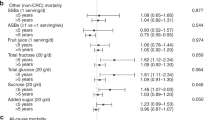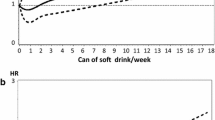Abstract
Barrett’s esophagus (BE) is the key precursor lesion of esophageal adenocarcinoma, a lethal cancer that has increased rapidly in westernized countries over the past four decades. Dietary sugar intake has also been increasing over time, and may be associated with these tumors by promoting hyperinsulinemia. The study goal was to examine multiple measures of sugar/starches intake in association with BE. This pooled analysis included 472 BE cases and 492 controls from two similarly conducted case–control studies in the United States. Dietary intake data, collected by study-specific food frequency questionnaires, were harmonized across studies by linking with the University of Minnesota Nutrient Database, and pooled based on study-specific quartiles. Logistic regression was used to calculate odds ratios (ORs) and 95% confidence intervals (CIs), adjusting for age, sex, race, total energy intake, study indicator, body mass index, frequency of gastro-esophageal reflux, and fruit/vegetable intake. In both studies, intake of sucrose (cases vs. controls, g/day: 36.07 vs. 33.51; 36.80 vs. 35.06, respectively) and added sugar (46.15 vs. 41.01; 44.18 vs. 40.68, respectively) were higher in cases than controls. BE risk was increased 79% and 71%, respectively, for associations comparing the fourth to the first quartile of intake of sucrose (ORQ4vs.Q1 = 1.79, 95% CI = 1.07–3.02, P trend = 0.01) and added sugar (ORQ4vs.Q1 = 1.71, 95% CI = 1.05–2.80, P trend = 0.15). Intake of sweetened desserts/beverages was associated with 71% increase in BE risk (ORQ4vs.Q1 = 1.71, 95% CI = 1.07–2.73, P trend = 0.04). Limiting dietary intake of foods and beverages that are high in added sugar, especially refined table sugar, may reduce the risk of developing BE.
Similar content being viewed by others
References
Kamangar F, Dores GM, Anderson WF. Patterns of cancer incidence, mortality, and prevalence across five continents: defining priorities to reduce cancer disparities in different geographic regions of the world. J Clin Oncol. 2006;24:2137–50.
Cook MB, Chow WH, Devesa SS. Oesophageal cancer incidence in the United States by race, sex, and histologic type, 1977–2005. Br J Cancer. 2009;101:855–9.
Steevens J, Botterweck AA, Dirx MJ, van den Brandt PA, Schouten LJ. Trends in incidence of oesophageal and stomach cancer subtypes in Europe. Eur J Gastroenterol Hepatol. 2010;22:669–78.
Jemal A, Siegel R, Xu J, Ward E. Cancer statistics, 2010. CA Cancer J Clin. 2010;60:277–300.
SEER Stat Fact Sheets: esophageal cancer, based on data from SEER 18 2006–2012. http://seer.cancer.gov/statfacts/html/esoph.html.p. Accessed 12 Sep 2016.
Kim R, Weissfeld JL, Reynolds JC, Kuller LH. Etiology of Barrett’s metaplasia and esophageal adenocarcinoma. Cancer Epidemiol Biomark Prev. 1997;6:369–77.
Johansson J, Håkansson HO, Mellblom L, Kempas A, Johansson KE, Granath F, et al. Risk factors for Barrett’s oesophagus: a population-based approach. Scand J Gastroenterol. 2007;42:148–56.
Corley DA, Kubo A, Levin TR, Block G, Habel L, Zhao W, et al. Abdominal obesity and body mass index as risk factors for Barrett’s esophagus. Gastroenterology. 2007;133:34–41 (quiz 311).
Cook MB, Shaheen NJ, Anderson LA, Giffen C, Chow WH, Vaughan TL, et al. Cigarette smoking increases risk of Barrett’s esophagus: an analysis of the Barrett’s and esophageal adenocarcinoma consortium. Gastroenterology. 2012;142:744–53.
Williams JL. Gastroesophageal reflux disease: clinical manifestations. Gastroenterol Nurs. 2003;26:195–200.
Hajek P, Stead LF, West R, Jarvis M, Hartmann-Boyce J, Lancaster T. Relapse prevention interventions for smoking cessation. Cochrane Database Syst Rev. 2013;8:CD003999.
Kramer FM, Jeffery RW, Forster JL, Snell MK. Long-term follow-up of behavioral treatment for obesity: patterns of weight regain among men and women. Int J Obes. 1989;13:123–36.
Popkin BM, Nielsen SJ. The sweetening of the world’s diet. Obes Res. 2003;11:1325–32.
Mulholland HG, Cantwell MM, Anderson LA, Johnston BT, Watson RG, Murphy SJ, et al. Glycemic index, carbohydrate and fiber intakes and risk of reflux esophagitis, Barrett’s esophagus, and esophageal adenocarcinoma. Cancer Causes Control. 2009;20:279–88.
Lahmann PH, Ibiebele TI, Webb PM, Nagle CM, Whiteman DC, Study AC. A case-control study of glycemic index, glycemic load and dietary fiber intake and risk of adenocarcinomas and squamous cell carcinomas of the esophagus: the Australian Cancer Study. BMC Cancer. 2014;14:877.
Tasevska N, Jiao L, Cross AJ, Kipnis V, Subar AF, Hollenbeck A, et al. Sugars in diet and risk of cancer in the NIH-AARP Diet and Health Study. Int J Cancer. 2012;130:159–69.
Renehan AG, Frystyk J, Flyvbjerg A. Obesity and cancer risk: the role of the insulin-IGF axis. Trends Endocrinol Metab. 2006;17:328–36.
Kaaks R, Lukanova A. Energy balance and cancer: the role of insulin and insulin-like growth factor-I. Proc Nutr Soc. 2001;60:91–106.
Herrigel DJ, Moss RA. Diabetes mellitus as a novel risk factor for gastrointestinal malignancies. Postgrad Med. 2014;126:106–18.
Kubo A, Corley DA, Jensen CD, Kaur R. Dietary factors and the risks of oesophageal adenocarcinoma and Barrett’s oesophagus. Nutr Res Rev. 2010;23:230–46.
Edelstein ZR, Farrow DC, Bronner MP, Rosen SN, Vaughan TL. Central adiposity and risk of Barrett’s esophagus. Gastroenterology. 2007;133:403–11.
Smith-Warner SA, Spiegelman D, Yaun SS, Albanes D, Beeson WL, van den Brandt PA, et al. Fruits, vegetables and lung cancer: a pooled analysis of cohort studies. Int J Cancer. 2003;107:1001–11.
Thompson OM, Beresford SA, Kirk EA, Vaughan TL. Vegetable and fruit intakes and risk of Barrett’s esophagus in men and women. Am J Clin Nutr. 2009;89:890–6.
Kubo A, Levin TR, Block G, Rumore GJ, Quesenberry CP, Buffler P, et al. Dietary antioxidants, fruits, and vegetables and the risk of Barrett’s esophagus. Am J Gastroenterol. 2008;103:1614–23 (quiz 24).
University of Minnesota Nutrition Coordinating Center (NCC) Food and Nutrient Database. University of Minnesota, Nutrition Coordinating Center: Minneapolis; 2014.
Petrick JL, Steck SE, Bradshaw PT, Trivers KF, Abrahamson PE, Engel LS, et al. Dietary intake of flavonoids and oesophageal and gastric cancer: incidence and survival in the United States of America (USA). Br J Cancer. 2015;112:1291–300.
Potischman N, Coates RJ, Swanson CA, Carroll RJ, Daling JR, Brogan DR, et al. Increased risk of early-stage breast cancer related to consumption of sweet foods among women less than age 45 in the United States. Cancer Causes Control. 2002;13:937–46.
Tavani A, Giordano L, Gallus S, Talamini R, Franceschi S, Giacosa A, et al. Consumption of sweet foods and breast cancer risk in Italy. Ann Oncol. 2006;17:341–5.
Bradshaw PT, Sagiv SK, Kabat GC, Satia JA, Britton JA, Teitelbaum SL, et al. Consumption of sweet foods and breast cancer risk: a case–control study of women on Long Island, New York. Cancer Causes Control. 2009;20:1509–15.
Liu S, Willett WC, Stampfer MJ, Hu FB, Franz M, Sampson L, et al. A prospective study of dietary glycemic load, carbohydrate intake, and risk of coronary heart disease in US women. Am J Clin Nutr. 2000;71:1455–61.
Wolever TM, Nguyen PM, Chiasson JL, Hunt JA, Josse RG, Palmason C, et al. Determinants of diet glycemic index calculated retrospectively from diet records of 342 individuals with non-insulin-dependent diabetes mellitus. Am J Clin Nutr. 1994;59:1265–9.
Wolever TM, Jenkins DJ, Jenkins AL, Josse RG. The glycemic index: methodology and clinical implications. Am J Clin Nutr. 1991;54:846–54.
Kubo A, Cook MB, Shaheen NJ, Vaughan TL, Whiteman DC, Murray L, et al. Sex-specific associations between body mass index, waist circumference and the risk of Barrett’s oesophagus: a pooled analysis from the international BEACON consortium. Gut. 2013;62:1684.
Thrift AP, Cook MB, Vaughan TL, Anderson LA, Murray LJ, Whiteman DC, et al. Alcohol and the risk of Barrett’s esophagus: a pooled analysis from the International BEACON consortium. Am J Gastroenterol. 2014;109:1586–94.
Greenland S, Pearl J, Robins JM. Causal diagrams for epidemiologic research. Epidemiology. 1999;10:37–48.
Smith-Warner SA, Spiegelman D, Ritz J, Albanes D, Beeson WL, Bernstein L, et al. Methods for pooling results of epidemiologic studies: the Pooling Project of Prospective Studies of Diet and Cancer. Am J Epidemiol. 2006;163:1053–64.
Rothman KJ, Greenland S, Lash TL. Modern epidemiology. 3rd ed. Philadelphia: Wolters Kluwer Health/Lippincott Williams & Wilkins; 2008.
Gilbert EW, Luna RA, Harrison VL, Hunter JG. Barrett’s esophagus: a review of the literature. J Gastrointest Surg. 2011;15:708–18.
Hosmer D, Lemeshow S. Applied logistic regression. New York: Wiley; 2000.
Willett W. Nutritional epidemiology. New York: Oxford University Press; 2012.
Crapo PA. Simple versus complex carbohydrate use in the diabetic diet. Annu Rev Nutr. 1985;5:95–114.
Steinmetz KA, Potter JD. Vegetables, fruit, and cancer prevention: a review. J Am Diet Assoc. 1996;96:1027–39.
Slavin JL. Mechanisms for the impact of whole grain foods on cancer risk. J Am Coll Nutr. 2000;19:300S–7S.
Watzl B. Anti-inflammatory effects of plant-based foods and of their constituents. Int J Vitam Nutr Res. 2008;78:293–8.
Monnier L, Mas E, Ginet C, Michel F, Villon L, Cristol JP, et al. Activation of oxidative stress by acute glucose fluctuations compared with sustained chronic hyperglycemia in patients with type 2 diabetes. JAMA. 2006;295:1681–7.
Kidane D, Chae WJ, Czochor J, Eckert KA, Glazer PM, Bothwell AL, et al. Interplay between DNA repair and inflammation, and the link to cancer. Crit Rev Biochem Mol Biol. 2014;49:116–39.
Spechler SJ. Clinical practice. Barrett’s Esophagus. N Engl J Med. 2002;346:836–42.
Weiss NS. Adjusting for screening history in epidemiologic studies of cancer: why, when, and how to do it. Am J Epidemiol. 2003;157:957–61.
Mokdad AH, Ford ES, Bowman BA, Dietz WH, Vinicor F, Bales VS, et al. Prevalence of obesity, diabetes, and obesity-related health risk factors, 2001. JAMA. 2003;289:76–9.
Corley DA, Schuppan D. Food, the immune system, and the gastrointestinal tract. Gastroenterology. 2015;148:1083–6.
Acknowledgements
This study was supported in part by grants from the National Institutes of Health (CA163060, CA72866, and DK63616).
Author information
Authors and Affiliations
Corresponding author
Ethics declarations
Conflict of interest
Dr. Nicholas Shaheen received research grant from C2 Therapeutics, CSA Medical, and Medtronic. Other authors declare that they have no conflict of interest.
Electronic supplementary material
Below is the link to the electronic supplementary material.
Rights and permissions
About this article
Cite this article
Li, N., Petrick, J.L., Steck, S.E. et al. Dietary sugar/starches intake and Barrett’s esophagus: a pooled analysis. Eur J Epidemiol 32, 1007–1017 (2017). https://doi.org/10.1007/s10654-017-0301-8
Received:
Accepted:
Published:
Issue Date:
DOI: https://doi.org/10.1007/s10654-017-0301-8




